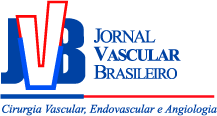Hidrocortisona reduz as concentrações séricas dos biomarcadores inflamatórios séricos em pacientes submetidos a endarterectomia de carótida
Hydrocortisone reduces serum concentrations of inflammatory biomarkers in patients subjected to carotid endarterectomy
Sthefano Atique Gabriel; Leila Antonangelo; Vera Luiza Capelozzi; Camila Baumann Beteli; Otacílio de Camargo Júnior; José Luis Braga de Aquino; Roberto Augusto Caffaro
Resumo
Palavras-chave
Abstract
Keywords
References
Teixeira BC, Lopes AL, Macedo RCO. Inflammatory markers, endothelial function and cardiovascular risk. J Vasc Bras. 2014;13(2):108-15.
Balanescu S, Calmac L, Constantinescu D, Marinescu M, Onut R, Dorobantu M. Systemic inflammation and early atheroma formation: are they related?. Maedica. 2010;5(4):292-301.
Tuttolomondo A, Di Raimondo D, Pecoraro R, Arnao V, Pinto A, Licata G. Atherosclerosis as an inflammatory disease. Curr Pharm Des. 2012;18(28):4266-88.
Moller MJ, Qin Z, Toursarkissian B. Tissue markers in human atherosclerotic carotid artery plaque. Ann Vasc Surg. 2012;26(8):1160-5.
Mauriello A, Sangiorgi GM, Virmani R. A pathobiologic link between risk factors profile and morphological markers of carotid instability. Atherosclerosis. 2010;208(2):572-80.
Wekesa AL, Cross KS, O’Donovan O. Predicting carotid artery disease and plaque instability from cell-derived microparticles. Eur J Vasc Endovasc Surg. 2014;48(5):489-95.
Hermus L, Lefrandt JD, Tio RA, Breek JC, Zeebregts CJ. Carotid plaque formation and serum biomarkers. Atherosclerosis. 2010;213(1):21-9.
Stahn C, Buttgereit F. Genomic and nongenomic effects of glucocorticoids. Nat Clin Pract Rheumatol. 2008;4(10):525-33.
Imamura K, Hayashi F, Suzumura A. [Cytokine production by peripheral blood monocytes/macrophages in the patients with multiple sclerosis and its suppression by methylprednisolone]. Rinsho Shinkeigaku. 1992;32(3):276-80.
Elenkov IJ. Neurohormonal-cytokine interactions: implications for inflammation, common human diseases and well-being. Neurochem Int. 2008;52(1-2):40-51.
Clinical alert: benefit of carotid endarterectomy for patients with high-grade stenosis of the internal carotid artery. National Institute of Neurological Disorders and Stroke Stroke and Trauma Division. North American Symptomatic Carotid Endarterectomy Trial (NASCET) investigators. Stroke. 1991;22(6):816-7.
Raja SG, Dreyfus GD. Modulation of systemic inflammatory response after cardiac surgery. Asian Cardiovasc Thorac Ann. 2005;13(4):382-95.
Rubens FD, Mesana T. The inflammatory response to cardiopulmonary bypass: a therapeutic overview. Perfusion. 2004;19(^sSuppl 1):S5-12.
Liguori GR, Kanas AF, Moreira LFP. Managing the inflammatory response after cardiopulmonary bypass: review of the studies in animal models. Rev Bras Cir Cardiovasc. 2014;29(1):93-102.
Kawamura T, Inada K, Okada H, Okada K, Wakusawa R. Methylprednisolone inhibits increase of interleukin 8 and 6 during open heart surgery. Can J Anaesth. 1995;42(5 Pt 1):399-403.
Komori K, Ishida M, Matsumoto T. Cytokine patterns and the effects of a preoperative steroid treatment in the patients with abdominal aortic aneurysms. Int Angiol. 1999;18(3):193-7.
Koutouzis M, Rallidis LS, Peros G. Serum interleukin-6 is elevated in symptomatic carotid bifurcation disease. Acta Neurol Scand. 2009;119(2):119-25.
Puz P, Lasek-Bal A, Ziaja D, Kazibutowska Z, Ziaja K. Inflammatory markers in patients with internal carotid artery stenosis. Arch Med Sci. 2013;9(2):254-60.
Alvarez Garcia B, Ruiz C, Chacon P, Sabin JA, Matas M. High-sensitivity C-reactive protein in high-grade carotid stenosis: risk marker for unstable carotid plaque. J Vasc Surg. 2003;38(5):1018-24.
Heider P, Poppert H, Wolf O. Fibrinogen and high-sensitive C-reactive protein as serologic predictors for perioperative cerebral microembolic lesions after carotid endarterectomy. J Vasc Surg. 2007;46(3):449-54.
Morrow DA, Ridker PM. C-reactive protein, inflammation, and coronary risk. Med Clin North Am. 2000;84(1):149-61, ix.
Baki ED, Sivaci RG, Kokulu S, Ela Y, Aldemir M. Effects of anesthetic choice on inflammatory response in cardiac surgery. Inflammation and Cell Signaling. 2014;1:e75.
Welsh P, Woodward M, Rumley A, Lowe G. Associations of circulating TNFalpha and IL-18 with myocardial infarction and cardiovascular risk markers: the Glasgow Myocardial Infarction Study. Cytokine. 2009;47(2):143-7.
Profumo E, Esposito C, Buttari B. Intracellular expression of cytokines in peripheral blood from patients with atherosclerosis before and after carotid endarterectomy. Atherosclerosis. 2007;191(2):340-7.
Russell DA, Abbott CR, Gough MJ. Vascular endothelial growth factor is associated with histological instability of carotid plaques. Br J Surg. 2008;95(5):576-81.
Szabó A, Laki J, Madsen HO. Early rise in serum VEGF and PDGF levels predisposes patients with a normal MBL2 genotype to restenosis after eversion endarterectomy. Stroke. 2007;38(8):2247-53.
Grufman H, Gonçalves I, Edsfeldt A. Plasma levels of high-sensitive C-reactive protein do not correlate with inflammatory activity in carotid atherosclerotic plaques. J Intern Med. 2014;275(2):127-33.



